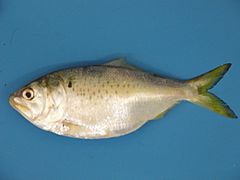Gulf menhaden facts for kids
The Gulf menhaden (Brevoortia patronus) is a small fish that lives in the ocean. It's a type of filter-feeding fish, which means it eats tiny bits from the water. It belongs to the herring family, called Clupeidae.
You can find Gulf menhaden all over the Gulf of Mexico, especially near the coast. They don't usually live in the far eastern Yucatán or western Cuba. Scientists believe the Gulf menhaden is like the Gulf of Mexico version of the Atlantic menhaden (Brevoortia tyrannus).
Both these fish are very important for big commercial fisheries. The Gulf menhaden fishery is the second largest in the United States by weight.
Quick facts for kids Gulf menhaden |
|
|---|---|
 |
|
| Gulf menhaden (Brevoortia patronus), captured in Galveston Bay, TX | |
| Conservation status | |
| Scientific classification | |
| Kingdom: | |
| Phylum: | |
| Class: | |
| Order: | |
| Family: | |
| Subfamily: | |
| Genus: |
Brevoortia
|
| Species: |
B. patronus
|
| Binomial name | |
| Brevoortia patronus Goode, 1878
|
|
Contents
Where Gulf Menhaden Live
Gulf menhaden live throughout the Gulf of Mexico, but they are not found everywhere in equal numbers. They are most common in the northwest and north-central Gulf. This is especially true in Louisiana and Texas, where there are many large groups of these fish.
In the southern Gulf, Gulf menhaden share their habitat with a fish called the finescale menhaden (Brevoortia gunteri). These two similar species have found ways to use different parts of the environment. In the eastern Gulf, Gulf menhaden live near the yellowfin menhaden (Brevoortia smithi). Scientists have even found that these two species can sometimes have babies together.
Gulf Menhaden Facts
Gulf menhaden are usually about 8 inches (20 cm) long. Some can grow up to 12 inches (30 cm). They are a dull silver color with a greenish back. Like their Atlantic cousins, they have a clear black spot behind their gill cover. There is also a row of smaller spots behind this main one.
What Gulf Menhaden Eat
Gulf menhaden are filter feeders. This means they get their food by filtering water through their gills. Their diet changes as they grow.
- When they are very young, called larvae, their gills are not fully developed. So, they mostly eat tiny animals called zooplankton.
- As they get a bit older, usually under one year old, they start to eat more phytoplankton. Phytoplankton are tiny plants that float in the water.
- When they are fully grown and their gills are completely developed, they mostly eat phytoplankton.
Gulf Menhaden Life Cycle
Gulf menhaden lay their eggs offshore during the winter months, from October to March. The eggs and young fish, called larvae, float freely in the open ocean. Ocean currents then carry them into calmer areas like estuaries, which are places where rivers meet the sea.
Because they can travel long distances with the currents, Gulf menhaden populations across the entire Gulf of Mexico are considered to be one big group.
Gulf Menhaden and People
Commercial Fishing
The Gulf menhaden fishery is one of the biggest fishing industries in the United States. In 2013, four of the top ten fishing ports in the country, by how much fish they caught, were involved with Gulf menhaden.
Most Gulf menhaden are caught to make fish meal and fish oil. These products are used in animal feed and supplements. A much smaller number of menhaden are caught to be used as bait for other fish. This fishery is not only large but also known for being sustainable. This means they fish in a way that keeps the fish population healthy for the future.
Organizations like Friend of the Sea have certified the Gulf menhaden fishery as sustainable. This is because the fish population is healthy. Also, the fishery catches very few other animals by accident, which is called bycatch. They achieve this by using special nets called purse seine nets.
Fun Fishing
Gulf menhaden are also important for people who fish for fun. Many anglers use them as bait to catch bigger fish.
How Gulf Menhaden are Managed
The Gulf menhaden fishery is managed by a group called the Gulf States Marine Fisheries Commission (GSMFC). In 2013, the GSMFC reported that Gulf menhaden were not being overfished. This means there are plenty of fish in the sea, and fishing is not harming their numbers.
The GSMFC says that the Gulf menhaden fishery is probably the most carefully watched and managed fishery in the Gulf of Mexico. For example, people who fish for menhaden with purse seine nets have been part of a program since 2011. This program has observers on their boats to watch how they fish. A special committee within the GSMFC, called the Menhaden Advisory Committee, helps manage these fish.
Dead Zones and Menhaden
Some people wonder if menhaden can help with "dead zones" in the ocean. Dead zones are areas where there isn't enough oxygen for most sea life to survive. These zones are often caused by too much pollution from human activities.
The GSMFC explains that menhaden mostly eat zooplankton, not the tiny plants (phytoplankton) that cause many dead zones. Also, menhaden release a lot of ammonia, which is a type of nitrogen. This can actually add to the nitrogen problem that helps create dead zones. The commercial fishery only catches adult menhaden, which eat zooplankton, not the young menhaden that eat phytoplankton.
See also
 In Spanish: Brevoortia patronus para niños
In Spanish: Brevoortia patronus para niños


